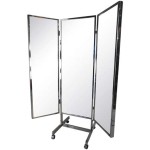Best Mirrors for the Bathroom
Bathrooms, often the smallest rooms in a house, play a significant role in daily routines. A key element in optimizing both the functionality and aesthetics of this space is the bathroom mirror. Selecting the right mirror involves considering various factors, ranging from size and shape to features and style. This article aims to provide a comprehensive guide to choosing the best mirror for individual bathroom needs.
One of the primary considerations when selecting a bathroom mirror is size. The mirror should be proportional to the vanity or wall space it occupies. A mirror too small can make the room feel cramped, while one too large can overwhelm the space. Generally, the mirror's width should not exceed the width of the vanity. For smaller bathrooms, a larger mirror can create the illusion of more space. Accurate measurements of the available space are essential before making a purchase.
Shape is another critical aspect of mirror selection. Rectangular mirrors are the most common choice due to their versatility and classic appeal. Round or oval mirrors can soften the lines of a bathroom and add a touch of elegance. Square mirrors offer a modern and clean aesthetic. Unconventional shapes, such as geometric or freeform mirrors, can serve as statement pieces, adding a unique design element to the bathroom.
Beyond size and shape, the features of a bathroom mirror can greatly enhance its functionality and convenience. Illuminated mirrors, also known as lighted mirrors, offer integrated lighting, often with adjustable brightness settings. These are particularly beneficial for applying makeup or grooming. Magnifying mirrors provide a close-up view, ideal for detailed tasks. Some mirrors incorporate both lighting and magnification. Fog-free mirrors prevent condensation buildup, ensuring a clear reflection even after a hot shower. These features, while adding to the cost, can significantly improve the usability of the mirror.
The style of the mirror should complement the overall bathroom design. For modern bathrooms, frameless mirrors or those with sleek metal frames offer a minimalist and contemporary look. Traditional bathrooms benefit from ornate frames made of wood or metal with decorative finishes. Rustic bathrooms can incorporate mirrors with reclaimed wood frames or wrought iron details. The mirror frame's finish should also coordinate with other hardware in the bathroom, such as faucets and light fixtures.
Installation methods vary depending on the mirror type and the bathroom wall. Some mirrors are designed to be hung using wires or brackets, while others are surface-mounted directly to the wall. Certain larger or heavier mirrors might require specialized installation techniques. It's crucial to ensure the wall can support the weight of the chosen mirror and to follow the manufacturer's installation instructions carefully. Professional installation is recommended for complex installations or particularly heavy mirrors.
Budget is an inevitable factor when selecting a bathroom mirror. Simple, frameless mirrors are generally the most affordable option. Mirrors with advanced features, such as built-in lighting or anti-fog technology, typically come at a higher price point. Ornate frames and premium materials also contribute to increased costs. It is advisable to set a budget beforehand and explore options within that range. Comparing prices from different retailers can help ensure a cost-effective purchase.
The quality of the mirror's construction is paramount. The mirror glass should be free from distortions and imperfections. The frame, if present, should be sturdy and well-made. Checking customer reviews and product specifications can provide insights into the mirror's durability and longevity. Investing in a high-quality mirror ensures a longer lifespan and avoids the need for frequent replacements.
Maintenance requirements should also be considered. Regular cleaning with a glass cleaner is essential for maintaining the mirror's clarity and shine. Avoid using abrasive cleaners, which can scratch the mirror surface. Mirrors with intricate frames might require more detailed cleaning to remove dust and debris from crevices. Choosing a mirror with easy-to-clean surfaces can simplify maintenance routines.
Finally, the location of the mirror within the bathroom influences its functionality and design considerations. The primary mirror above the vanity serves the most practical purpose. Secondary mirrors, such as those placed on a side wall, can provide additional viewing angles or enhance the sense of space. Careful consideration of the mirror's placement optimizes its utility and aesthetic contribution to the bathroom.
Choosing the right bathroom mirror involves a careful evaluation of various factors. By considering size, shape, features, style, installation, budget, quality, maintenance, and placement, individuals can select a mirror that not only meets their practical needs but also enhances the overall aesthetic of their bathroom.

Best Lighted Bathroom Mirrors To Buy In 2024

35 Best Bathroom Mirrors Of 2024 Top Picks

27 Bathroom Mirror Ideas For Every Style Wall Decor

The Best Mirror Ideas For Your Bathroom Design Modern Luxury

35 Best Bathroom Mirrors Of 2024 Top Picks

10 Spectacular Ideas For Backlit Bathroom Mirrors

Best Bathroom Mirrors For Your Space Delta Faucet

What Type Of Mirror Is Best For Bathrooms Ledmyplace

6 Best Smart Mirrors Of 2024 Mirror Reviews

Best Led Vanity Mirrors Of 2024 In Toronto Bliss Bath Kitchen








